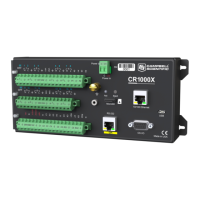electrodes. The centre electrode is used for excitation; because it is encircled by the ground
electrode, the path for a ground loop through the soil is greatly reduced. Moisture blocks that
consist of two parallel plate electrodes are particularly susceptible to ground loop problems.
Similar considerations apply to the geometry of the electrodes in water conductivity sensors.
The ground electrode of the conductivity or soil moisture probe and the datalogger earth ground
form a galvanic cell, with the water/soil solution acting as the electrolyte. If current is allowed to
flow, the resulting oxidation or reduction will soon damage the electrode, just as if dc excitation
was used to make the measurement. Campbell Scientific resistive soil probes and conductivity
probes are built with series capacitors to block this dc current. In addition to preventing sensor
deterioration, the capacitors block any dc component from affecting the measurement.
See also Grounds (p. 10).
9.8 Field calibration
Calibration increases accuracy of a measurement device by adjusting its output, or the
measurement of its output, to match independently verified quantities. Adjusting sensor output
directly is preferred, but not always possible or practical. By adding the FieldCal() or
FieldCalStrain() instruction to a CRBasic program, measurements of a linear sensor can
be adjusted by modifying the programmed multiplier and offset applied to the measurement,
without modifying or recompiling the CRBasic program. For more information, see the CRBasic
help.
9.9 File system error codes
Errors can occur when attempting to access files on any of the available drives. All occurrences
are rare, but they are most likely to occur when using optional memory cards. Often, formatting
the drive will resolve the error. The errors display in the File Control messages box or in the
CardStatus field of the Status table. See Information tables and settings descriptions (p. 128) for
more information.
1 Invalid format
2 Device capabilities error
3 Unable to allocate memory for file operation
4 Max number of available files exceeded
5 No file entry exists in directory
6 Disk change occurred
7 Part of the path (subdirectory) was not found
8 File at EOF
9 Bad cluster encountered
10 No file buffer available
9. Tips and troubleshooting 122

